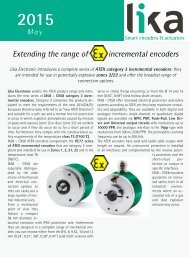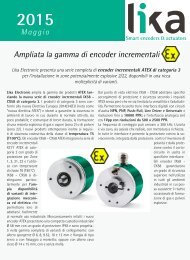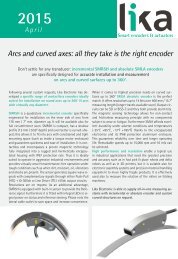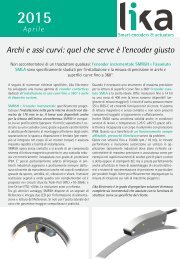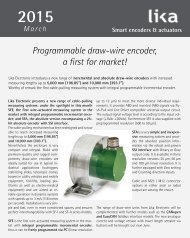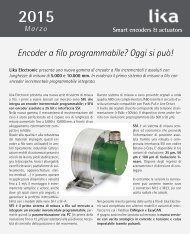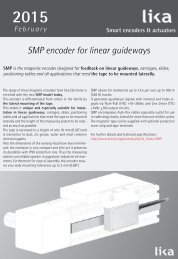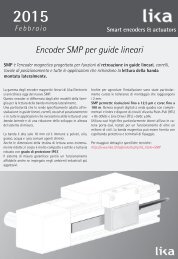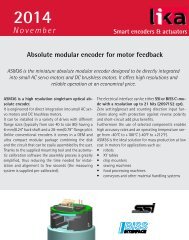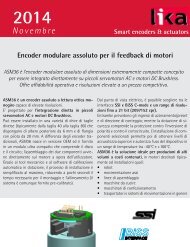LINEPULS & LINECOD catalogue 2016 in English
Lika Electronic incremental and absolute linear encoders catalogue 2016 in English Our new linear encoders catalogue is out now, and features many innovative new products and up-to-date information. The catalogue is expressly designed to set out the comprehensive range of incremental & absolute linear encoders from Lika Electronic. Check it out, it is completely renewed! Make sure you don’t miss out on a copy, download the pdf file from our web site or request your hard copy now! We have also got an interactive digital version in the works that shall be released soon!
Lika Electronic incremental and absolute linear encoders catalogue 2016 in English
Our new linear encoders catalogue is out now, and features many innovative new products and up-to-date information. The catalogue is expressly designed to set out the comprehensive range of incremental & absolute linear encoders from Lika Electronic. Check it out, it is completely renewed!
Make sure you don’t miss out on a copy, download the pdf file from our web site or request your hard copy now!
We have also got an interactive digital version in the works that shall be released soon!
You also want an ePaper? Increase the reach of your titles
YUMPU automatically turns print PDFs into web optimized ePapers that Google loves.
<strong>LINECOD</strong><br />
Absolute output circuits and fieldbus <strong>in</strong>terfaces<br />
At each change of the clock signal and at each subsequent ris<strong>in</strong>g edge (2) one bit is clocked<br />
out at a time, up to LSB, so complet<strong>in</strong>g the data word transmission.<br />
The cycle ends at the last ris<strong>in</strong>g edge of the clock signal (3). This means that up to n + 1<br />
ris<strong>in</strong>g edges of the clock signals are required for each data word transmission (where n is the<br />
bit resolution); for <strong>in</strong>stance, a 13-bit encoder needs m<strong>in</strong>imum 14 clock edges.<br />
If the number of clocks is greater than the number of bits of the data word, then the system<br />
will send a zero (low logic level signal) at each additional clock, zeros will either lead (LSB<br />
ALIGNED protocol) or follow (MSB ALIGNED protocol) or lead and/or follow the data word<br />
(TREE FORMAT protocol).<br />
After the period TM monoflop time, hav<strong>in</strong>g a typical duration of 16 μsec, calculated from<br />
the end of the clock signal transmission, the encoder is ready for the next transmission and<br />
therefore the data signal is switched high.<br />
SSI <strong>in</strong>terface has a frequency of data transmission rang<strong>in</strong>g between 100 kHz and 2 MHz.<br />
The clock frequency (baud rate) depends on the length of the cable and must comply with<br />
the technical <strong>in</strong>formation reported <strong>in</strong> the follow<strong>in</strong>g table:<br />
Max. cable length<br />
m [ft] @<br />
Clock frequency<br />
[kHz]<br />
400<br />
[1310]<br />
200<br />
[655]<br />
100<br />
[330]<br />
75<br />
[245]<br />
60<br />
[200]<br />
30<br />
[100]<br />
15<br />
[50]<br />
100 200 300 400 500 900 1800<br />
At ambient temperature (23°C)<br />
The clock signal has a typical logic level of 5V, the same as the output signal which has<br />
customarily a logic level of 5V <strong>in</strong> compliance with the RS-422 standard.<br />
The output code can be either B<strong>in</strong>ary or Gray.<br />
SSI at a glance:<br />
Number of<br />
stations<br />
Sett<strong>in</strong>g the<br />
nodes<br />
Sett<strong>in</strong>g the<br />
baud rate<br />
Transmission<br />
rate<br />
Cable length<br />
- - - Up to 2Mbit/s Up to 400 m<br />
Cable<br />
Lika M8 type<br />
cable<br />
At ambient temperature (23°C)<br />
“LSB right aligned” protocol allows to right align the bits, the transmission beg<strong>in</strong>s from<br />
MSB (most significant bit) to LSB (least significant bit); LSB is then sent at the last clock<br />
cycle. The word has an overall length of 25 bits. If the number of clock signals is higher<br />
than the data bits, then unused bits are forced to low logic level (0) and lead the data word.<br />
So, if the device needs 20 bits to provide the position <strong>in</strong>formation, then unused bits (from<br />
21 to 25) are set to 0 (zero).<br />
“LSB RIGHT ALIGNED” protocol<br />
LSB RIGHT ALIGNED protocol scheme (BA- and GA- output circuit codes)<br />
37




